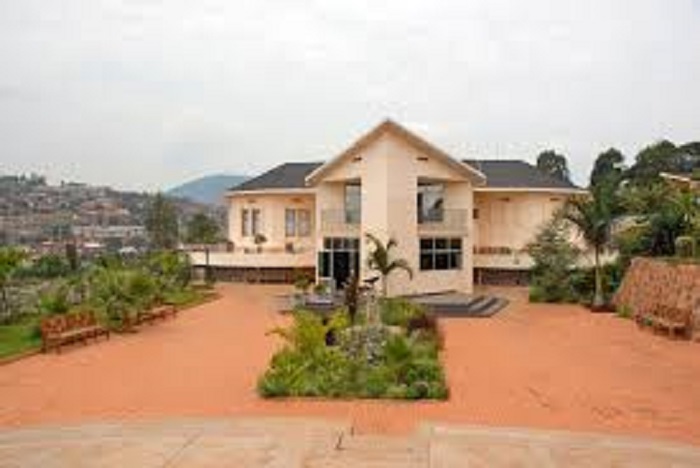
Sheltering behind a tree around an eighth of his width, with huge arms folded across his chest and his head bowed, Kigoma looks as unimpressed by the rain as I am. The 24-year-old silverback mountain gorilla also seems unfazed by a group of humans treading carefully around him, while we are all giddy with excitement at our first sighting for the day.
A few steps around the corner we spot another silverback sitting with the fluffy ball of an infant curled up next to him and, further on, there’s a mother tucked away cradling her infant, keeping it warm and dry while she breastfeeds. As I try to capture the scene with my camera, our eyes lock and she yawns.
I’m on a gorilla trek in the Volcanoes National Park, Rwanda, and we’ve just found the Kwisanga family. This newly formed group was named at Kwita Izina 2022, an annual ceremony where baby gorillas are officially named and Rwanda’s commitment to sustainable and responsible tourism is celebrated.
Conservation of mountain gorillas is a Rwandan success story, with a recent census showing that the population had grown by 26% over six years. While wet weather may not seem like ideal trekking conditions, our guide Sebanani Jean reassures us that it will allow us to observe the family in more detail while they are sheltering and less inclined to move

High value, low-volume tourism
Another factor that allows us to feel close to this group is that numbers are limited for gorilla trekking in Rwanda, with a maximum of eight people per day allowed to visit each family. “We use the high value, low-volume approach to gorilla trekking,” Michaella Rugwizangoga, the Rwanda Development Board’s chief tourism officer tells me.
« This ensures that tourists are able to meet these gentle giants for one lifechanging hour, while guaranteeing that the gorillas aren’t stressed. It also enables us to keep tourism at a level that brings economic development with minimal negative environmental impact. »
Michaella adds that Rwanda’s strategy is « pro-conservation and pro-people » as its tourism revenue sharing scheme ensures communities living around the country’s national parks receive 10% of all tourism revenue. And while Rwanda’s gorillas will be a massive draw for clients, there’s much more to see and do, which Visit Rwanda is investing in.
Akagera National Park is now home to a thriving population of white and black rhinos
Michaella says: « Our strategy is to position Rwanda as a tourism powerhouse on the continent and beyond. We have restocked previously locally extinct species with the recent introduction of white rhinos in Akagera National Park and the park is now home to a thriving population of white and black rhinos.
« Some other changes we have made include a policy to open Rwanda and connect her to the rest of the world. Rwanda is ranked third for visa openness in Africa as anyone can get a visa on arrival. »
RwandAir is introducing a new non-stop service from London Heathrow to Kigali on November 7 and increasing its service from three flights a week to four, while a new airport, Bugesera, is also currently being built so that the number of flights to the country can be expanded.
The range of hotels available is increasing too, with new properties such as the Four Points by Sheraton Kigali joining brands such as Marriott, Radisson Blu, Serena and One and Only.

The big five
To complement my gorilla trek, I go in search of the big five at Akagera National Park in the east of the country. On a game drive I feel optimistic after seeing elephants and buffalo early on but, despite sightings of rhino nearby, they remain elusive to us, as do lions and leopards.
A behind-the-scenes tour at Akagera National Park will be of interest for clients who want to learn more about how the park works, but a highlight on my trip is a boat safari on Lake Ihema.
I see crocodiles sunbathing, elephants striding on the shore, the otherworldly figures of hippos with pink ears and nostrils protruding from the water
Zipping across the beautifully still water at 7am, I see crocodiles sunbathing, elephants striding on the shore, the otherworldly figures of hippos with pink ears and nostrils protruding from the water, and a variety of birds including posing sea eagles and a palm-nut vulture.
A more sober activity is a visit to the Kigali Genocide Memorial in Rwanda’s capital. It’s a harrowing experience, but learning about the 1994 genocide against the Tutsi people feels essential. The museum is immersive with videos showing testimonies from survivors and a Children’s Room, which has an exhibition dedicated to the children who lost their lives.

Investing in nature
Kigali offers wildlife spotting opportunities too. At Umusambi Village, where more than 50 endangered grey crowned cranes have been saved from the illegal pet trade, I try to snap pictures of woodland kingfishers, African paradise flycatchers and the spiky heads of the cranes themselves.
Later at Nyandungu Eco-Park, in a restored wetland area, I hear how the new park is the largest addition to public green space in Kigali. It’s this important emphasis on conservation to protect the country’s majestic, fascinating wildlife that has become the prevailing theme of my trip.
Something Teddy Mugabo, chief executive of the Rwanda Green Fund, confirms when talking at the park. « Investing in nature is the best investment we can make, » he says. I couldn’t agree more.
Subscribe to view notification of our daily news
RwandaPodium © All Rights Reserved. Powered by thesublime.rw